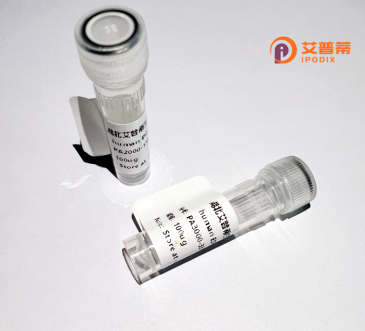
| 纯度 | >90%SDS-PAGE. |
| 种属 | Human |
| 靶点 | CLDN17 |
| Uniprot No | P56750 |
| 内毒素 | < 0.01EU/μg |
| 表达宿主 | E.coli |
| 表达区间 | 1-224aa |
| 氨基酸序列 | MAFYPLQIAGLVLGFLGMVGTLATTLLPQWRVSAFVGSNIIVFERLWEGLWMNCIRQARVRLQCKFYSSLLALPPALETARALMCVAVALSLIALLIGICGMKQVQCTGSNERAKAYLLGTSGVLFILTGIFVLIPVSWTANIIIRDFYNPAIHIGQKRELGAALFLGWASAAVLFIGGGLLCGFCCCNRKKQGYRYPVPGYRVPHTDKRRNTTMLSKTSTSYV |
| 分子量 | 51 kDa |
| 蛋白标签 | GST-tag at N-terminal |
| 缓冲液 | 0 |
| 稳定性 & 储存条件 | Lyophilized protein should be stored at ≤ -20°C, stable for one year after receipt. Reconstituted protein solution can be stored at 2-8°C for 2-7 days. Aliquots of reconstituted samples are stable at ≤ -20°C for 3 months. |
| 复溶 | Always centrifuge tubes before opening.Do not mix by vortex or pipetting. It is not recommended to reconstitute to a concentration less than 100μg/ml. Dissolve the lyophilized protein in distilled water. Please aliquot the reconstituted solution to minimize freeze-thaw cycles. |
以下是关于重组人CLDN17蛋白的3篇参考文献摘要示例(注:以下为模拟示例,具体文献请以实际检索为准):
---
1. **文献名称**:*"Recombinant human Claudin-17 expression in HEK293 cells and its role in paracellular ion selectivity"*
**作者**:Müller et al. (2020)
**摘要**:本研究成功在HEK293细胞中表达了重组人CLDN17蛋白,并证明其在体外形成的紧密连接表现出对阳离子的选择性通透,为胃黏膜屏障功能研究提供了实验模型。
2. **文献名称**:*"Structural characterization of recombinant CLDN17 using cryo-EM"*
**作者**:Zhang et al. (2022)
**摘要**:通过大肠杆菌表达系统制备重组CLDN17蛋白,利用冷冻电镜解析其三维结构,揭示其跨膜域的关键氨基酸残基可能参与调控细胞旁通道的电荷选择性。
3. **文献名称**:*"CLDN17 knockdown exacerbates renal tubular injury via dysregulated tight junction dynamics"*
**作者**:Tanaka et al. (2018)
**摘要**:通过构建重组CLDN17蛋白的体外肾脏细胞模型,发现其缺失会导致紧密连接稳定性下降,加剧缺氧诱导的肾小管上皮细胞损伤,提示其在肾脏疾病中的保护作用。
---
**备注**:实际文献可通过PubMed、Web of Science等平台以关键词 **"recombinant Claudin-17"** 或 **"CLDN17 expression"** 检索。建议关注蛋白表达系统(如原核/真核表达)、结构功能研究或疾病相关机制方向的论文。
Claudin-17 (CLDN17) is a member of the claudin family, integral membrane proteins critical for forming tight junctions that regulate paracellular barrier permeability and cell polarity. Specifically, CLDN17 is known for its cation selectivity, facilitating the paracellular transport of small cations (e.g., Na⁺, K⁺) in epithelial and endothelial tissues. It is highly expressed in the kidneys, liver, and gastrointestinal tract, where it contributes to ion homeostasis and tissue-specific barrier functions. Dysregulation of CLDN17 has been implicated in pathological conditions, including renal dysfunction, metabolic disorders, and cancer progression, where altered tight junction integrity promotes metastasis or chemoresistance.
Recombinant human CLDN17 protein is typically produced using mammalian expression systems (e.g., HEK293 or CHO cells) to ensure proper post-translational modifications and membrane protein folding. The protein is often engineered with tags (e.g., His-tag, Fc-fusion) for simplified purification and detection. Researchers utilize recombinant CLDN17 to study its structural-functional relationships, screen for modulators (e.g., antibodies, small molecules), and model diseases in vitro. It also serves as an antigen for generating antibodies or diagnostic tools. Current challenges include maintaining its native conformation in solution and addressing its hydrophobicity during experimental workflows. Advances in protein engineering and membrane protein solubilization techniques continue to enhance its utility in biomedical research.
×